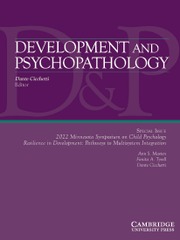Crossref Citations
This article has been cited by the following publications. This list is generated based on data provided by
Crossref.
Sethi, Arjun
McCrory, Eamon
Puetz, Vanessa
Hoffmann, Ferdinand
Knodt, Annchen R.
Radtke, Spenser R.
Brigidi, Bartholomew D.
Hariri, Ahmad R.
and
Viding, Essi
2018.
Primary and Secondary Variants of Psychopathy in a Volunteer Sample Are Associated With Different Neurocognitive Mechanisms.
Biological Psychiatry: Cognitive Neuroscience and Neuroimaging,
Vol. 3,
Issue. 12,
p.
1013.
Lee, Steve S.
2018.
Multidimensionality of Youth Psychopathic Traits: Validation and Future Directions.
Journal of Psychopathology and Behavioral Assessment,
Vol. 40,
Issue. 1,
p.
86.
Frick, Paul J.
Robertson, Emily L.
and
Clark, Julia E.
2018.
Developmental Pathways to Disruptive, Impulse-Control and Conduct Disorders.
p.
139.
Cecil, Charlotte A. M.
McCrory, Eamon J.
Barker, Edward D.
Guiney, Jo
and
Viding, Essi
2018.
Characterising youth with callous–unemotional traits and concurrent anxiety: evidence for a high-risk clinical group.
European Child & Adolescent Psychiatry,
Vol. 27,
Issue. 7,
p.
885.
Robertson, Emily L.
Frick, Paul J.
Ray, James V.
Thornton, Laura C.
Wall Myers, Tina D.
Steinberg, Laurence
and
Cauffman, Elizabeth
2018.
The Associations Among Callous-Unemotional Traits, Worry, and Aggression in Justice-Involved Adolescent Boys.
Clinical Psychological Science,
Vol. 6,
Issue. 5,
p.
671.
Meffert, Harma
Thornton, Laura C.
Tyler, Patrick M.
Botkin, Mary L.
Erway, Anna K.
Kolli, Venkata
Pope, Kayla
White, Stuart F.
and
Blair, R. James R.
2018.
Moderation of prior exposure to trauma on the inverse relationship between callous-unemotional traits and amygdala responses to fearful expressions: an exploratory study.
Psychological Medicine,
Vol. 48,
Issue. 15,
p.
2541.
Marchegiani, Vanessa
Zampieri, Fabio
Della Barbera, Mila
and
Troisi, Alfonso
2018.
Gender differences in the interrelations between digit ratio, psychopathic traits and life history strategies.
Personality and Individual Differences,
Vol. 135,
Issue. ,
p.
108.
Ortner, Nora
Preiß, Maximilian
and
Sevecke, Kathrin
2018.
„Psychopathy“ im Kindes- und Jugendalter.
Forensische Psychiatrie, Psychologie, Kriminologie,
Vol. 12,
Issue. 3,
p.
207.
Frazier, Annabelle
Ferreira, Patricia A.
and
Gonzales, Joseph E.
2019.
Born this way? A review of neurobiological and environmental evidence for the etiology of psychopathy.
Personality Neuroscience,
Vol. 2,
Issue. ,
Kimonis, Eva R.
Fleming, Georgette E.
Wilbur, Rhonda R.
Groer, Maureen W.
and
Granger, Douglas A.
2019.
Dehydroepiandrosterone (DHEA) and its ratio to cortisol moderate associations between maltreatment and psychopathology in male juvenile offenders.
Psychoneuroendocrinology,
Vol. 101,
Issue. ,
p.
263.
Goulter, Natalie
Kimonis, Eva R.
Denson, Thomas F.
and
Begg, Denovan P.
2019.
Female primary and secondary psychopathic variants show distinct endocrine and psychophysiological profiles.
Psychoneuroendocrinology,
Vol. 104,
Issue. ,
p.
7.
Viding, Essi
and
McCrory, Eamon
2019.
Towards understanding atypical social affiliation in psychopathy.
The Lancet Psychiatry,
Vol. 6,
Issue. 5,
p.
437.
Boecker, Lea
and
Pauli, Paul
2019.
Affective startle modulation and psychopathology: Implications for appetitive and defensive brain systems.
Neuroscience & Biobehavioral Reviews,
Vol. 103,
Issue. ,
p.
230.
Vasileva, Mira
Petermann, Ulrike
and
Petermann, Franz
2019.
Traumatische Erfahrungen und Callous-unemotional Traits: Zusammenhang mit funktionalen und dysfunktionalen Emotionsregulationsstrategien.
Zeitschrift für Psychiatrie, Psychologie und Psychotherapie,
Vol. 67,
Issue. 2,
p.
125.
Cardinale, Elise M.
Ryan, Rebecca M.
and
Marsh, Abigail A.
2020.
Maladaptive Fearlessness: An Examination of the Association Between Subjective Fear Experience and Antisocial Behaviors Linked With Callous Unemotional Traits.
Journal of Personality Disorders,
p.
1.
Huang, Jiasheng
Fan, Linlin
Lin, Kexiu
and
Wang, Yuyin
2020.
Variants of Children with Psychopathic Tendencies in a Community Sample.
Child Psychiatry & Human Development,
Vol. 51,
Issue. 4,
p.
563.
Northam, Jaimie C.
and
Dadds, Mark R.
2020.
Is Callous Always Cold? A Critical Review of the Literature on Emotion and the Development of Callous–Unemotional Traits in Children.
Clinical Child and Family Psychology Review,
Vol. 23,
Issue. 2,
p.
265.
Wagner, Nicholas J.
and
Waller, Rebecca
2020.
Leveraging parasympathetic nervous system activity to study risk for psychopathology: The special case of callous-unemotional traits.
Neuroscience & Biobehavioral Reviews,
Vol. 118,
Issue. ,
p.
175.
Rhoads, Shawn A.
Cardinale, Elise M.
O’Connell, Katherine
Palmer, Amy L.
VanMeter, John W.
and
Marsh, Abigail A.
2020.
Mapping neural activity patterns to contextualized fearful facial expressions onto callous-unemotional (CU) traits: intersubject representational similarity analysis reveals less variation among high-CU adolescents.
Personality Neuroscience,
Vol. 3,
Issue. ,
Mokros, Andreas
Hare, Robert D.
Neumann, Craig S.
and
Habermeyer, Elmar
2020.
The Wiley International Handbook on Psychopathic Disorders and the Law.
p.
107.


